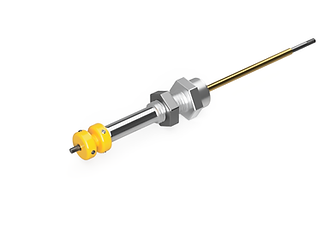
C172 Mix lever
This page is split into three main sections:
Parts Guide
Print Guide
Build Guide
The ultimate printer I can recommend is the Bambu Labs X1 carbon with AMS or P1P if you have deep pockets. ($1200). It's a massive leap forward in 3D printing, with excellent quality and impressive speeds. It's pretty much press print and go as the software and hardware do the calibration before each print.

This design was a real challenge from the start. The main aim was to allow for micro-adjustment and rapid lever adjustment. This would allow the unit to operate like a real aircraft. Hidden in the centre section is a screw thread in which a 3mm ball bearing runs. The lever can be operated in course adjustment by pushing the end button. For fine adjustment, the knob is turned clockwise or anticlockwise. This build will require metal rods and tubes, which can not be 3d printed. Check out the parts guide.
General Information:

Build Guide

Click on image for more details
STEP:
1
Place the 10K ohm linear potentiometer onto the Pot Base (1). Secure with Qty4, M3 x 6mm screws.

Click on image for more details
STEP:
2
Next, we need to create the Rod assy with the micro-adjustment. Some people might find this a little taxing. Refer to the PDF:
https://031b6b45-11f6-46a7-ab8e-17be9aef4dad.usrfiles.com/ugd/031b6b_8b9898e3353043658477b0e79cfbda8e.pdf

Click on image for more details
STEP:
3
Drill a 3.5mm hole in the tube at the dimensions shown in the PDF.

Click on image for more details
STEP:
4
I highly recommend brass or aluminium for this 4mm diameter rod. Steel can be used, but not stainless steel. This is because cutting a thread on each end becomes harder with each material upgrade. The filed section in the middle is easy to achieve. Use a file slanted to around 30 degrees. Ensure the serrated side of the file is used against the rod. Dont go too deep. Keep fitting the rod inside the tube, Place the ball bearing into the slot. The bearing need to sit flush or just below the surface of the outer tube. The ball bearing is 3mm in diameter or can be obtained by taking the bearings out of a rotary switch.

Click on image for more details
STEP:
5
When the rod is pushed into the tube, the bearing needs to sit flush like this

Click on image for more details
STEP:
6
When the rod is pulled, the bearing needs to ride up out of the hole,

Click on image for more details
STEP:
7
Allow the bearing to sit fully in the hole, Insert the rod assy into the mix screw (2)

Click on image for more details
STEP:
8
Insert the Ferrule assy (8) onto the outer tube. Secure with M3 x 6mm grub screws.

Click on image for more details
STEP:
9
Place an M4 nut on the rod. This becomes the rod stop. There should be enough room for nuts to allow the position of the rod to be adjusted.

Click on image for more details
STEP:
10
Place the Mix knob (3) onto the brass outer tube. Secure with M3 x 6mm grub screws.

Click on image for more details
STEP:
11
Place spring at the end of the knob (3). this comes from an amazon assorted spring box. Select one that you feels provides the right feel and is strong enough to ensure it moves the rod and bearing up. You may need to use two smaller springs to achieve the correct force required.

Click on image for more details
STEP:
12
Screw the Push Button onto the rod.

Click on image for more details
STEP:
13
When the push button (4) is released, the spring pulls the rod out, causing the bearing to rise into the screw thread of the body. This allows for micro-adjustment of the mixing lever. By turning the mixing lever, the ball bearing ride in the reverse thread screwing the lever in or out depending on the direction of rotation.

Click on image for more details
STEP:
14
Pushing the button in against the spring allows the bearing to fall inside the tube, disengaging from the screw thread. The mixing lever can now be pushed in and out easily.

Click on image for more details
STEP:
15
Attach the pot base and clamp (7) with Qty 4, M4 x 30mm screws.

Click on image for more details
STEP:
16
The unit is ready to be fitted to the sim.
